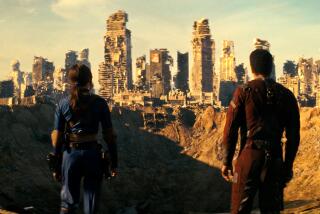TV Series Goes Digital : No Cameras Roll at First All-Computer Production
- Share via
In the Burbank studio where the fantasy television series “Wild Space” is being shot, three actors dressed in medieval garb walk up a path to a castle guarded by several squadrons of “orcs” and demand entry. Except there is no path, no castle, and the orcs are nowhere in sight.
With a blue ramp in the center of a bare blue room providing the only semblance of a set, the scene looks more like some postmodern minimalist vision set to life than the magical world of dragons and wizards called for in the script. But director Flint Dille is unfazed.
“It’ll all be digitally pasted in later,” he says, emerging from behind a video camera attached to a souped-up Macintosh Quadra computer.
In the production’s all-digital environment, a handful of actors are replicated in the computer to create whole armies. Sets are shot separately as miniatures and combined with the action once it is safely stored as digital zeros and ones in the Mac. Two-headed cobras are computer-generated. There is no videotape until the very end. And it’s all done for about $250,000 an episode, a modest sum even by the standards of traditional children’s animation shows.
If the plans work out, “Wild Space” will probably be the first syndicated live-action television series produced entirely on desktop computers. But it’s not likely to be the last. As computer prices plummet and the technology improves, the future of television production may look a lot like this.
To be sure, some of the techniques are crude, and nearly all are experimental. To store and manipulate the vast amounts of digital data without resorting to the more powerful and expensive computer power in a traditional post-production facility, for example, digital production director Scott Billups worked to develop portable hard drives with massive storage capabilities.
One frame of video is equivalent to about the amount of data that fits on a typical floppy disk used in personal computers. At 30 frames a second, a half-hour show would fill up enough floppies to fill several “Wild Space” kingdoms.
Billups then has a bunch of computer jockeys do the time-consuming process of combining “layers” of data into a complete scene at home on their own Quadras, using a hard drive full of data and a new video compression board that allows for the capture and manipulation of full-frame, broadcast-quality video.
Dille’s main challenge is getting the actors to remember where they’re supposed to be and what they’re supposed to be doing in the blue vacuum that is their set. A digital version of their surroundings projected on TV screens above the camera helps give them an idea. And since the camera records directly into the computer, the “Wild Space” technical crew can immediately see a rough version of how a fully composited shot will look. Still, it’s a far cry from being on location.
But then, there is no existing location that resembles “Wild Space,” which is one reason that decided to opt for experimental digital production. The Lake Geneva, Wis.-based game publishing company is financing the series in conjunction with the development of its $40 board game of the same name.
Best known for its addictive role-playing game “Dungeons and Dragons,” TSR’s first television venture, “Dragonstrike”--also linked to a board game--will air as a Thanksgiving week special on KCOP-TV Channel 13 in Los Angeles and in several other markets.
The firm has commissioned 13 half-hour episodes of “Wild Space,” which it hopes to begin airing late next year, shortly after the game is released in stores. Plans are to position it against children’s afternoon animation shows, although TSR hopes the digital effects and high production values will also attract teen-agers. A video will also be included in the game.
“We felt that if we’re going to be noticed, we’re going to have to be different,” says TSR marketing vice president Rick Behling. “But we knew if you wanted to do this optically, it would cost a fortune.”
Indeed, while digital effects are becoming fairly common in commercials, they have been largely reserved for science fiction TV programs such as “Star Trek: The Next Generation” and “Babylon Five.” Director George Lucas used digital techniques in his “Young Indiana Jones” series to create early-20th-Century locations that no longer exist. But skeptics say digital production is not widespread simply because the contemporary sitcom doesn’t need it.
Dille disagrees. “Basically a lot of people in this town have a large investment in the past,” he says. “We’re scuzzy enough and new enough that we have absolutely no investment in the past.”
More to Read
The biggest entertainment stories
Get our big stories about Hollywood, film, television, music, arts, culture and more right in your inbox as soon as they publish.
You may occasionally receive promotional content from the Los Angeles Times.










